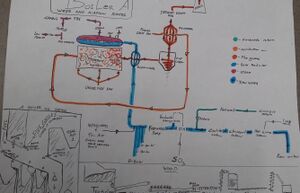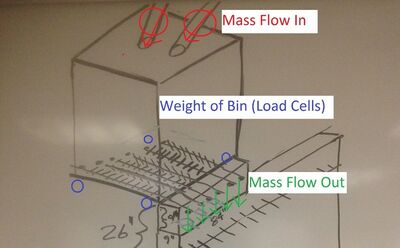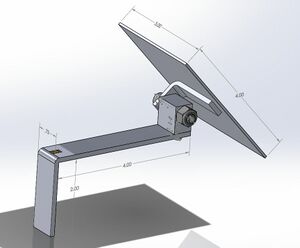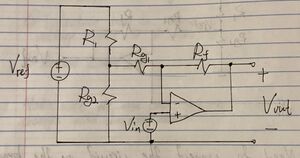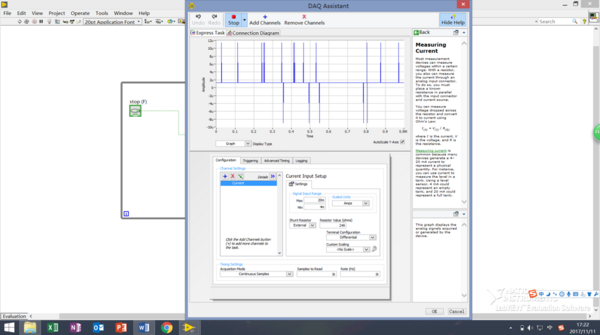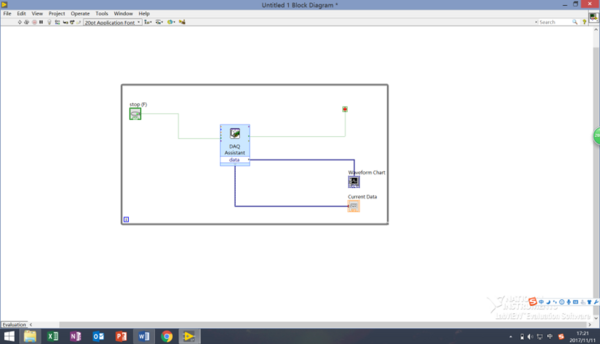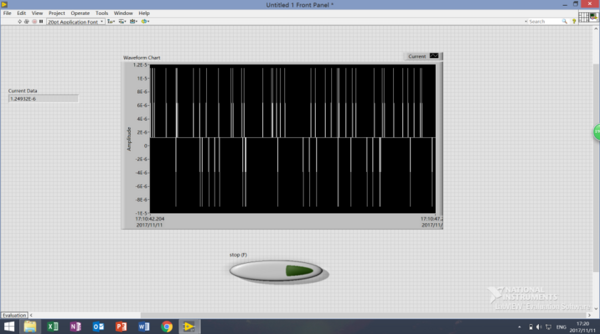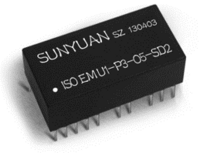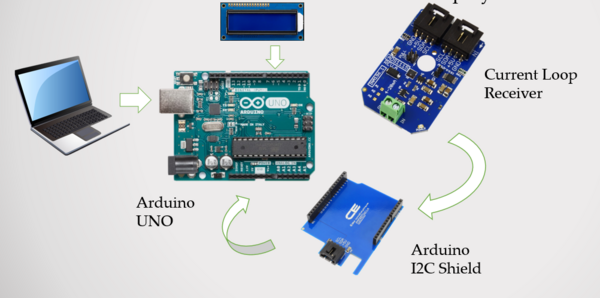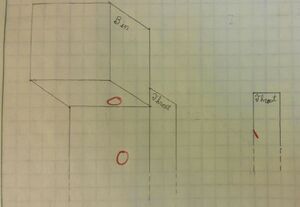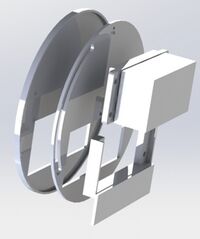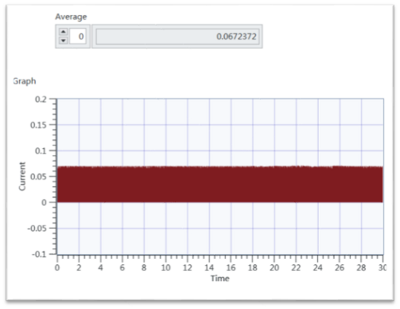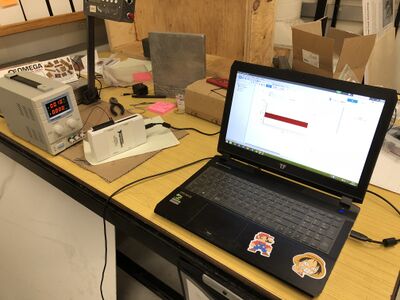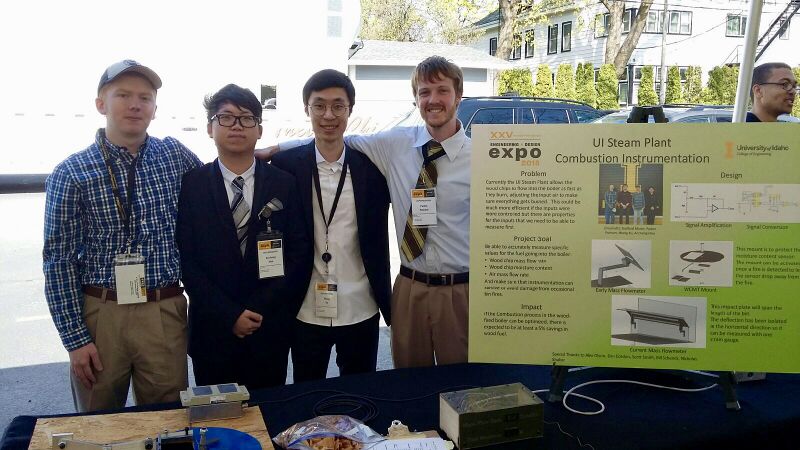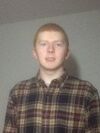UI Steam Plant Combustion Input Measurement Systems
| The System of The Boiler | |
| Team Name | Rolling Timber |
| Clients | Scott Smith |
| Instructor | Dr. Daniel Cordon |
| Consultant | Dr. Alex, Dr. Scott, Dr. Daniel |
| Group Numbers | Stafford Morse, Paden Putnam, Ancheng Hou, Wang Xu |
| Duration | Fall 2017 - Spring 2018 |
UI Steam Plant Combustion Input Measurement Systems The goal of project is to measure the data of the wood fired boiler in college. Such the mass flow of the wood chips, the moisture of the wood chips and the air flow into or out of the boiler. One of the most important part of the project is creating a sensor to measure the mass flow of wood chips.
Problem Definition[edit | edit source]
Background[edit | edit source]
The wood fired boiler at university of Idaho is driven by the wood fuel and air. The goal of project is to measure the data of the wood fired boiler in college. Such the mass flow of the wood chips, the moisture of the wood chips and the air flow into or out of the boiler. One of the most important part of the project is creating a sensor to measure the mass flow of wood chips.
Project Goals[edit | edit source]
1. UI steam plant currently uses “microwave method”
2. Want to be able to measure:
- Mass flow rate of wood chips
- Moisture content of wood chips
- Mass flow rate of air
3. End goal is to have automated boiler control
- Optimal combustion efficiency
- That is outside the scope of this project
Project Learning[edit | edit source]
1. We are going to learn more about how to use LabVIEW.
- Basic operating
- Connecting to a DAQ, and then measure the DAQ.
2. We have already done a lot of researches.
- Air Mass Flow
- Stack Humidity
- Woodchip mass flow
- Woodchip moisture content
Specifications[edit | edit source]
1. Woodchip Mass Flow into throat
- Target Accuracy of 3% or better
- Range of 2.3 - 7 green tons/hour
- Survivable in occasional bin fires
2. Woodchip Moisture Content
- Target Accuracy of 3% or better
- Range of 3 - 60% - may change depending on mixing
- Survivable in occasional bin fires
3. Mass air flow into boiler
- Underfire and Overfire air
- Target Accuracy of 3% or better
- Measured in single duct before diverging
- Retains accuracy in dusty environment
Project Planning[edit | edit source]
Meeting Time[edit | edit source]
1. Team meeting at each Tuesday 3:30 pm
2. Meeting with consultant and Client at each Thursday 3:30pm
Gantt Chart[edit | edit source]
Design[edit | edit source]
Previously Researched Options[edit | edit source]
- Off-the-shelf bulk mass flowmeters provide required accuracy
- Expensive and requires major structural modifications to route chips
- Bin weighing requires less work, but does not deliver required accuracy
Woodchip Mass Flow[edit | edit source]
Throat dimensions[edit | edit source]
This is a general draft of the Throat dimensions. In this picture, you can see the model of one part of our boiler. You can see the length at the same time. The woodchips will fall from above the box. Then the woodchips will be smashed more smaller by the machine under the box.
The model of the mass flow sensor[edit | edit source]
This is the model we design for our mass flow sensor. We will use this equipment to measure the data of our woodchips mass flow. In order to measure the mass flow of the woodchips, we need to connect the sensor to our DAQ, so we can get the data in the LabVIEW. Then, when the woodchips fall from above and touch the contact surface, the angle in our mass flow sensor will change. At the same time, the data in our LabVIEW will change. We can get the measurement of current from the sensor. After all, we will calculate the mass flow of woodchips.
Amplifier[edit | edit source]
In order to make our data more accurate, we need an amplifier to adjust our voltage. Here is the circuit and the simplified circuit.
LabVIEW[edit | edit source]
Tools: LabVIEW Software, NI USB-6008 DAQ
DAQ Assistant in LabVIEW[edit | edit source]
In our project,we need to use LabVIEW to simulate the system of our sensors, and get the measurement from the LabVIEW. In the LabVIEW, we use DAQ Assistant to set up a 4mA-20mA input current signal.
Simulation of our system[edit | edit source]
In this step, I will show you the simulate system of our system. From this picture, you can find out how does our system work.
Wave Chart of our measurement[edit | edit source]
After we set up the input current signal by using the DAQ Assistant, we add a Wave Chart in the LabVIEW, so we can see how does our measurements change. We can see the current changes with time.
Signal Conversion[edit | edit source]
Use the chip to convert the 0-5 V voltage signal to the 4-20mA current signal
LCD Display[edit | edit source]
Ideas for self-contained 4-20 mA calibrated display
Wood Chip Moisture Content Measurement[edit | edit source]
WCMT (Wood Chip Moisture Transmitter)
| WCMT Placement
|
WCMT Mounting
|
Estimated Costs:
- Aluminum: ~$30
- Steel: ~$225
Testing result[edit | edit source]
After we connect each part of our project together, we can read the data from the DAQ. We can get a graph changes with the changing of mass flow. Here is the picture.
Team Number[edit | edit source]
